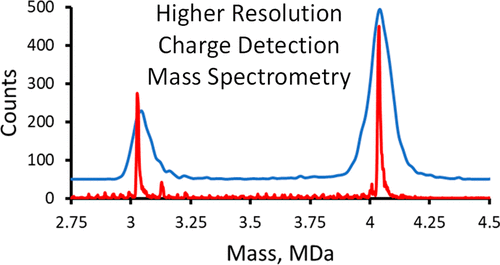当前位置:
X-MOL 学术
›
Anal. Chem.
›
论文详情
Our official English website, www.x-mol.net, welcomes your
feedback! (Note: you will need to create a separate account there.)
Higher Resolution Charge Detection Mass Spectrometry.
Analytical Chemistry ( IF 6.7 ) Pub Date : 2020-08-03 , DOI: 10.1021/acs.analchem.0c02133 Aaron R Todd , Lauren F Barnes , Kim Young , Adam Zlotnick , Martin F Jarrold
Analytical Chemistry ( IF 6.7 ) Pub Date : 2020-08-03 , DOI: 10.1021/acs.analchem.0c02133 Aaron R Todd , Lauren F Barnes , Kim Young , Adam Zlotnick , Martin F Jarrold

|
Charge detection mass spectrometry is a single particle technique where the masses of individual ions are determined from simultaneous measurements of each ion’s m/z ratio and charge. The ions pass through a conducting cylinder, and the charge induced on the cylinder is detected. The cylinder is usually placed inside an electrostatic linear ion trap so that the ions oscillate back and forth through the cylinder. The resulting time domain signal is analyzed by fast Fourier transformation; the oscillation frequency yields the m/z, and the charge is determined from the magnitudes. The mass resolving power depends on the uncertainties in both quantities. In previous work, the mass resolving power was modest, around 30–40. In this work we report around an order of magnitude improvement. The improvement was achieved by coupling high-accuracy charge measurements (obtained with dynamic calibration) with higher resolution m/z measurements. The performance was benchmarked by monitoring the assembly of the hepatitis B virus (HBV) capsid. The HBV capsid assembly reaction can result in a heterogeneous mixture of intermediates extending from the capsid protein dimer to the icosahedral T = 4 capsid with 120 dimers. Intermediates of all possible sizes were resolved, as well as some overgrown species. Despite the improved mass resolving power, the measured peak widths are still dominated by instrumental resolution. Heterogeneity makes only a small contribution. Resonances were observed in some of the m/z spectra. They result from ions with different masses and charges having similar m/z values. Analogous resonances are expected whenever the sample is a heterogeneous mixture assembled from a common building block.
中文翻译:

更高分辨率的电荷检测质谱。
电荷检测质谱是一种单粒子技术,通过同时测量每个离子的m / z比和电荷来确定单个离子的质量。离子穿过导电圆柱体,并检测圆柱体上感应的电荷。圆柱体通常放置在静电线性离子阱内,以便离子在圆柱体中来回振荡。通过快速傅立叶变换对所得时域信号进行分析;振荡频率产生m / z ,并且电荷由幅度确定。质量分辨率取决于这两个量的不确定性。在之前的工作中,质量分辨率较低,约为 30-40。在这项工作中,我们报告了大约一个数量级的改进。这一改进是通过将高精度电荷测量(通过动态校准获得)与更高分辨率的m / z测量相结合来实现的。通过监测乙型肝炎病毒 (HBV) 衣壳的组装来对性能进行基准测试。 HBV 衣壳组装反应可产生中间体的异质混合物,从衣壳蛋白二聚体延伸到具有 120 个二聚体的二十面体T = 4 衣壳。所有可能大小的中间体以及一些过度生长的物种都得到了解决。尽管质量分辨率有所提高,但测量的峰宽仍然受仪器分辨率的影响。异质性只做出很小的贡献。在一些m / z谱中观察到共振。它们是由具有相似m / z值的不同质量和电荷的离子产生的。 只要样品是由共同构建块组装而成的异质混合物,就会出现类似的共振。
更新日期:2020-08-18
中文翻译:

更高分辨率的电荷检测质谱。
电荷检测质谱是一种单粒子技术,通过同时测量每个离子的m / z比和电荷来确定单个离子的质量。离子穿过导电圆柱体,并检测圆柱体上感应的电荷。圆柱体通常放置在静电线性离子阱内,以便离子在圆柱体中来回振荡。通过快速傅立叶变换对所得时域信号进行分析;振荡频率产生m / z ,并且电荷由幅度确定。质量分辨率取决于这两个量的不确定性。在之前的工作中,质量分辨率较低,约为 30-40。在这项工作中,我们报告了大约一个数量级的改进。这一改进是通过将高精度电荷测量(通过动态校准获得)与更高分辨率的m / z测量相结合来实现的。通过监测乙型肝炎病毒 (HBV) 衣壳的组装来对性能进行基准测试。 HBV 衣壳组装反应可产生中间体的异质混合物,从衣壳蛋白二聚体延伸到具有 120 个二聚体的二十面体T = 4 衣壳。所有可能大小的中间体以及一些过度生长的物种都得到了解决。尽管质量分辨率有所提高,但测量的峰宽仍然受仪器分辨率的影响。异质性只做出很小的贡献。在一些m / z谱中观察到共振。它们是由具有相似m / z值的不同质量和电荷的离子产生的。 只要样品是由共同构建块组装而成的异质混合物,就会出现类似的共振。











































 京公网安备 11010802027423号
京公网安备 11010802027423号